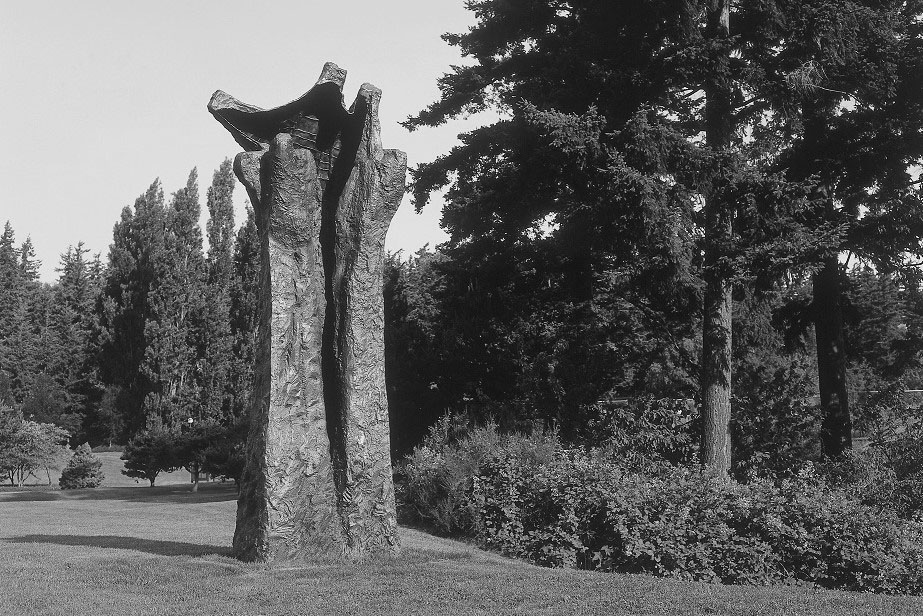Manus Response Video
Artist Statement
One of the most essential aspects of Manus that we wanted to bring to life in our representation of the sculpture was texture. We also incorporated Manus’s resemblance to human form and its ability to blend into the surrounding environment into our own piece.
While many sculptures are created to be inviting and aesthetically pleasing to the eyes of those visiting the area, Manus’s structure more resembles that of a mutilated arm, a dead and broken tree, or even a cold and muddy naked body. Instead of juxtaposing its environment by contrasting to the nature world via man-made beauty, Manus is camouflaged in an northwestern environment filled with towering evergreens and the bare winter carcasses of deciduous trees.
This idea, of the human body being apart of nature and subject to decay is interpreted in our piece by layering the body in mud then sculpting directly on the body with tools. This imitates the textures of the sculpture so we can revisualize Manus’s form as organic and alive. By recreating the textures of mud and Earth, the human form also vanishes into its surroundings. The gash down the center of the sculpture is represented in the crevices of the stones behind the subject as well as in the last shot of the subject in the video. This evokes a correlation to the fragility of nature and the decaying process of organisms and trees that Manus elicits.
Manus:
Magdalena Abakanowicz’s Manus, made and installed on the southern end of Western Washington University’s campus in 1994, is a heavily textured bronze monolithic sculpture. The piece is part of Abakanowicz’s Hand-like Trees series started in the nineties, which emphasizes the relationship and comparison between the man-made and natural world.
The sculpture is not particularly beautiful, nor is it made to stand out from its surroundings. Manus is an echo of the environment that surrounds it as much as it is an echo of Abakanowicz’s past. Some who have viewed the sculpture note the violent gash on the eastern face of Manus and compared it to the violence perhaps seen by Abakanowicz herself as a young child growing up in Poland during World War II. Others compare Manus’s sturdy, tree trunk-like structure to the trees Abakanowicz herself played in as a child.
Magdalena Abakanowicz:
Magdalena Abakanowicz was born in 1930 to an aristocratic Polish-Russian family. When she was nine, World War II broke out in Europe and after the end of the war, Poland was under Soviet control for roughly forty-five years. Even as a child Abakanowicz wanted to sculpt but had no materials to do so. Limited by lack of both medium and physical space to work in, her first pieces were Abakans, made from 1966-1975.
These pieces were massive sculptures made of woven burlap fabric, allowed them to be folded up and stored in small spaces, but become gigantic once unfurled. This began Abakanowicz’s fascination with texture, nature, and humanity. Although many of her earlier works were soft, made of fabrics, sacking, and stuffing, her later pieces were made with solid, hard materials. Manus is one of these solid pieces, made of beeswax and bronze, still standing after nearly two and a half decades.
Group Statement:
Seeing Manus in person lead us, as a group, to note some key pieces of the sculpture we wanted to focus on. The first was Manus’s texture, which is that of rough-sculpted clay that has been violently molded by what appears to be many, many hands. This texture became vital to our own representation of the sculpture, and is one of the key aspects we chose to focus on.
We also noted that the sculpture is not made to fit in with traditional ideas of beauty or grace, Manus is meant to blend in with the nature around it. Unlike other sculptures, which may be created to add to the environment, becoming the centerpiece to a larger setting (which becomes secondary), Manus is apart of its own setting and does not overshadow any piece of its surroundings.
For us, Manus’s beauty came from the elaborate texture that holds hundreds, perhaps thousands of fingerprints and tool marks. All of which give the sculpture its ability to blend in to the natural world despite being a man-made object.
Credit:
Video by Lily Foss
Manus photo taken by Jesse Sturgis, edited by Lola Krauss-Lucas
Research by Jason Stockwell, Lola Krauss-Lucas, & Lily Foss
Blog Compilation by Jason Stockwell
“Manus” & “Magdalena Abakanowicz” written by Lola Krauss-Lucas
Artist Statement written by Lola Krauss-Lucas & Lily Foss
Bibliography:
Abakanowicz, Magdalena. Manus. 1994, Western Washington University. westerngallery.wwu.edu/sculpture/manus., by Sarah Clark-Langager and Jesse Sturgis.
Clark-Langager, Sarah. “Western Washington University.” Western Gallery, westerngallery.wwu.edu/sculpture/manus.
Gola, Jola. “Magdalena Abakanowicz.” Magdalena Abakanowicz, Studio S, 2006, www.abakanowicz.art.pl/index.php.html.
“Manus.” University Public Art Collection, by Sarah A. Clark-Langager, Western Washington University, 2014.

Leave a Reply